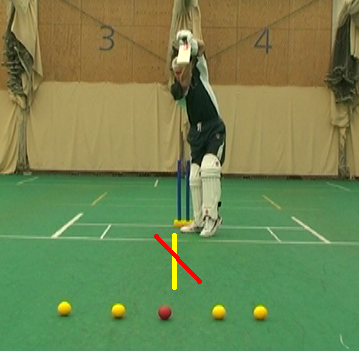|
To celebrate the World Twenty20, PitchVision Academy batting coach Gary Palmer has written his guide to getting maximum runs in minimum time. Gary has coached many players into county cricket over the years, If you would like coaching from Gary, check out CCM Academy.
The best and most consistent Twenty20 batters in international cricket generally play proper cricket shots.
They play down the ground with the full face of the bat as their preferred scoring option. This is because it is very difficult to succeed in Twenty20 without having the basics in place. The risks of failure are too high.
For you to follow the example of top players you also need to have a good basic batting technique from which to improvise and attach additional flair shots.
Maximise hitting zone
Because Twenty20 cricket requires you to score off more deliveries and more frequently it is of vital to maximise your hitting zone (the amount of the swing where the line of the bat and the ball are matched together). This is done by keeping he bat going through the line of the ball for the maximum amount of time with the full face of the bat at the ball.
In the picture below a long hitting zone is shown by the yellow line. You can see how much smaller the zone becomes if your bat does not come down straight, as the red line illustrates:

Playing straight along the yellow line will minimise your risks of making mistakes.
To consistently and effectively have a long hitting zone you need to be well balanced, well aligned to where you want to hit the ball and play with exaggerated finishing positions where you fully complete the shots with good technique. Some coaches call this 'good shape'.
Technically, this means the old fashioned coaching advice was right all along: Maintain a high leading elbow after the shot, especially when hitting down the ground. Dropping the elbow shortens the hitting zone and minimises the amount of deliveries you can hit down the ground in the v.
You can learn drills to improve your hitting zone for the Twenty20 cricket on PitchVision Academy
Build from the base
You would be highly successful in Twenty20 if you simply perfected the straight shots combined with cuts and pulls. However, once you have mastered these shots you can start to adapt further.
You can hit gaps in the field and manoeuvre the ball with use of high leading elbow when playing straight batted shots. Simply close the face on impact to hit specific areas. This means the bat will swing in a straight throughout the shot and the risks of getting out are minimised. Go for small changes of angle to hit gaps rather than wide angle changes.
However, left Handed hitting and reverse sweeps should be played in moderation. They are very high risks shots. These shots are more for showmanship rather than the team's benefit. Only use these shots as a last resort.
If you are going to improvise and play a shot of the highest risk make sure it's one that will get you a boundary, preferable a six. There is very little point doing it just to score 1 or 2 runs as you can do that with more conventional shots at a lower risk.
The longer you maintain the process of controlled hitting with good technique the more successful you will be when improvising in a Twenty20 run chase situation. Don't panic and get drawn into mindless slogging with poor technique as the risks are too high.
Safe improvisation: Clear the front leg
It is still possible to score quickly and hit boundaries while minimising risk.
You can score off almost any length ball with a large hitting zone by learning to clear the front leg.
Clearing the leg allows you to swing the bat in as straight a line as possible with the option of hooking cutting and pulling the ball when it is shorter, this can be done by stepping back and across towards off stump against pace bowlers thus giving you more time before you select what shot you want to play. This back and across movement looks like this:
From this position you are able to drive, cut, hook and pull as shown here:
 
 

The more you open your shoulders and clear the front leg the more options are open to you to hit down the ground with the full face of the bat.
If the ball is moving (either swing or spin) you can make the follow adaptations to the technique:
- Ball moving away, leg side line. Try to step inside the line of the delivery aligning both feet straight and then look to hit on the leg side.
- Ball moving away off side line. Look to back away slightly and hit on the offside. Backing away will help you to get your front foot across the line of the back foot thus helping you to turn your leading shoulder and putting you in a great position to hit on the off side.
- Ball moving in, off side line. Hit straight in the v.
- Ball moving in, middle/leg side line. Look to step across the crease and get in line or inside the line of the delivery so that you can align you feet straight or open up the front leg towards the leg side to enable you to hit with the spin/swing.
All of the above methods allow you to swing the bat in a straight line to the target area, but remember to maintain a high leading elbow for efficiency and consistency of shot.
Hitting against the swing/spin when the ball is moving in to you causes you to be closed off and therefore cramped up. It also causes you to hit across the line which is of high risk.
image credit: irishcricketphotos

If you want to learn everything there is to know about technique, check out Gary Palmer's interactive coaching courses. Gary is a coach with over 20 years experience teaching players to become first class cricketers. For the first time he has put his drills online, only at PitchVision Academy.
Discuss this article with other subscribers
|









